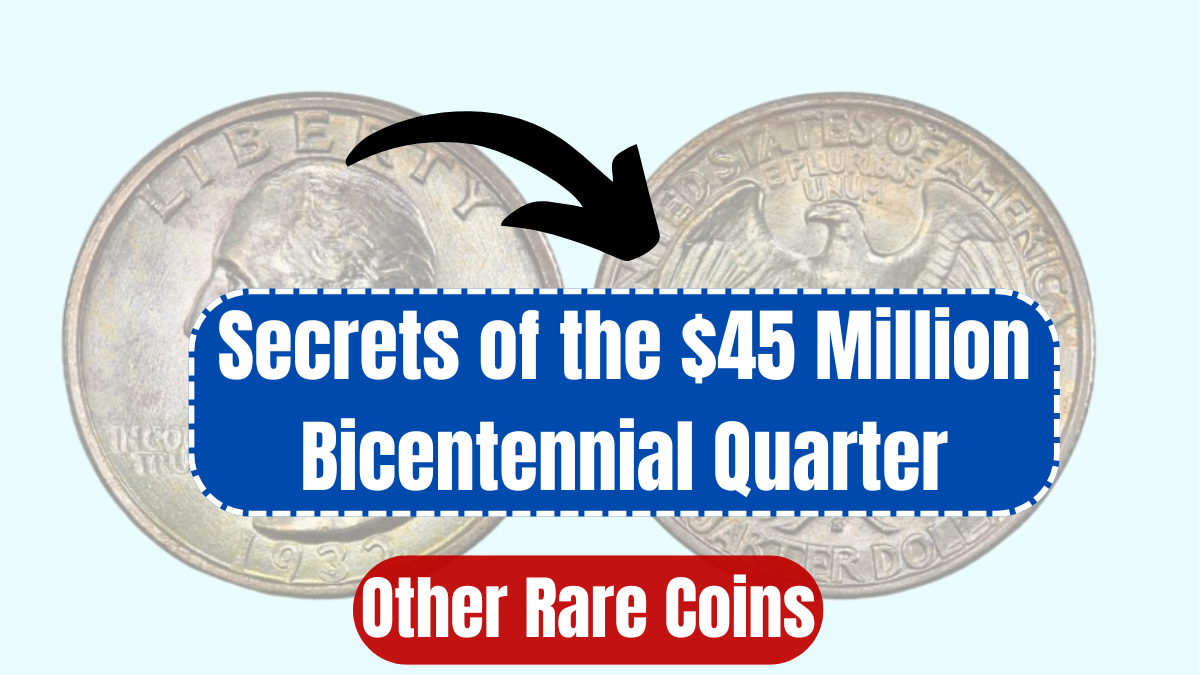One of the most talked-about coins in American history is the 1976 Bicentennial Quarter, reportedly worth up to $45 million under extraordinary conditions. This coin was minted to celebrate the 200th anniversary of the United States, featuring a distinctive “1776–1976” dual date and a Colonial Drummer design on the reverse.
While most of these quarters are still worth face value, certain factors can elevate their price dramatically, though claims of $45 million sales are highly exaggerated and unverified.

Why Some Bicentennial Quarters Are Worth Thousands
Several key attributes can significantly increase the value of a Bicentennial Quarter:
- Mint Errors: Quarters with rare flaws like double die strikes, misaligned edges, or off-center prints are highly collectible.
- Silver Composition: A limited number were minted in 40% silver for collectors. These have greater intrinsic and collector value.
- Mint Mark: Proof coins minted in San Francisco with an “S” mint mark tend to be more valuable.
- High Grades: Coins graded MS-67 or higher by PCGS or NGC, especially those in uncirculated condition, can fetch a high price at auctions.
Although there are rumors of multimillion-dollar Bicentennial Quarters, the actual highest known auction values are significantly lower, usually in the thousands rather than millions.
How to Identify a Valuable Bicentennial Quarter
Follow these steps to check if your Bicentennial Quarter is valuable:
- Check the Mint Mark: Look for an “S” for San Francisco-minted proof coins.
- Inspect for Errors: Look closely for doubled letters, images, or any irregularities in the design.
- Evaluate the Condition: A coin that’s clean, uncirculated, and well-preserved is worth more.
- Weigh the Coin: Silver quarters weigh around 5.75 grams, while standard copper-nickel coins weigh 5.67 grams.
If your coin seems promising, it’s best to get it professionally evaluated by the Professional Coin Grading Service (PCGS) or Numismatic Guaranty Corporation (NGC).
4 Other Rare U.S. Coins Worth Over $20,000
Here are four coins that have captured massive interest in the numismatic world and brought in high returns for lucky owners:
| Coin | Why It’s Valuable | Approximate Value |
|---|---|---|
| 1913 Liberty Head Nickel | Only 5 known; iconic rarity in U.S. coin history. | $3.7 million |
| 1943 Bronze Lincoln Cent | Mistakenly struck in bronze during WWII; extremely rare. | $336,000 |
| 1792 Silver Center Cent | Early experimental coin with a silver plug; highly prized for historic relevance. | $352,500 |
| 1652 New England Threepence | Among the first colonial coins minted in America. | $2.5 million |
Each of these coins stands out due to a combination of rarity, historical context, and condition—a trifecta that serious collectors are always seeking.
What Makes a Coin Valuable?
The following factors determine whether a coin is worth more than face value:
- Rarity: The fewer examples exist, the more valuable the coin becomes.
- Historical Significance: Coins tied to key historical events or time periods gain collector interest.
- Minting Errors: Any manufacturing flaws—like misstrikes or double dies—make coins unique and highly prized.
- Condition and Grade: Coins in mint or uncirculated condition, especially those professionally graded, hold significantly more value.
- Metal Composition: Coins containing precious metals like silver or gold are intrinsically worth more.
Understanding these features can help you evaluate coins in your possession—or potentially find one worth a fortune.
Should You Get Your Coins Appraised?
If you believe you possess a rare or error coin, you should always:
- Avoid cleaning the coin (it can reduce its value).
- Contact certified grading services like PCGS or NGC for authentication.
- Store it properly to prevent damage or wear.
Many valuable coins have been found in pocket change, flea markets, or inherited collections. A simple inspection could be the difference between owning a 25-cent coin and a $25,000 collector’s item.
FAQs
Is the $45 million Bicentennial Quarter real?
The claim of a $45 million sale is mostly a myth. However, rare error coins and silver versions in MS-67+ condition can be worth thousands of dollars.
What is the most valuable Bicentennial Quarter ever sold?
While exact figures vary, the highest recorded sales for rare Bicentennial Quarters have been in the five-figure range, not millions.
How can I tell if my quarter is silver?
Weigh the coin. A silver Bicentennial Quarter weighs around 5.75 grams and may have an “S” mint mark from San Francisco.
Do all Bicentennial Quarters have value?
No. Most are worth only face value unless they feature mint errors, are made of silver, or are in uncirculated condition.
Where can I sell a rare coin?
You can sell coins through auction houses, certified dealers, or online platforms after getting them graded and authenticated.
What does “MS-67” mean in coin grading?
“MS” stands for Mint State. A grade of MS-67 indicates an almost perfect, uncirculated coin, which can greatly increase its value.
Are there other coins worth more than $20,000?
Yes. Rare U.S. coins like the 1913 Liberty Head Nickel and 1943 Bronze Lincoln Cent have fetched hundreds of thousands to millions.
Can cleaning my coin increase its value?
No. Cleaning a coin often damages its surface and can decrease its value significantly. Experts recommend leaving coins untouched.
Click here to know more.
Aanchal is a passionate writer with a keen interest in storytelling, content creation, and creative expression. She enjoys exploring diverse topics and crafting engaging narratives that captivate readers.